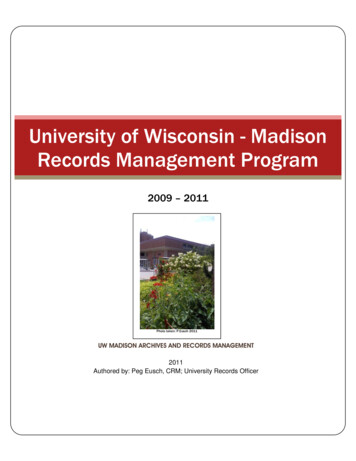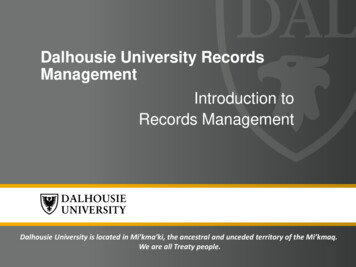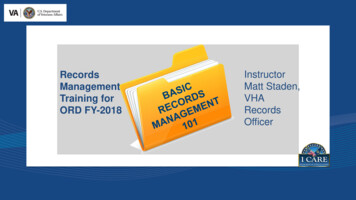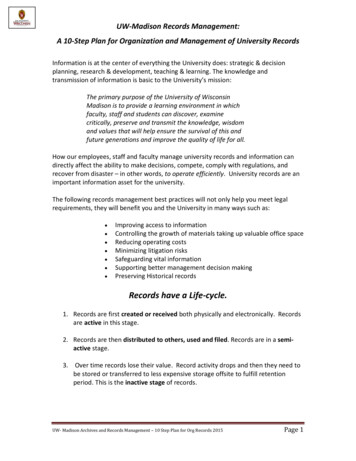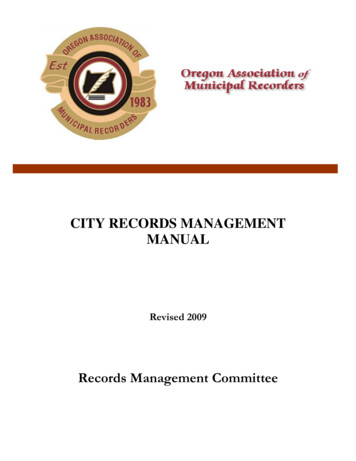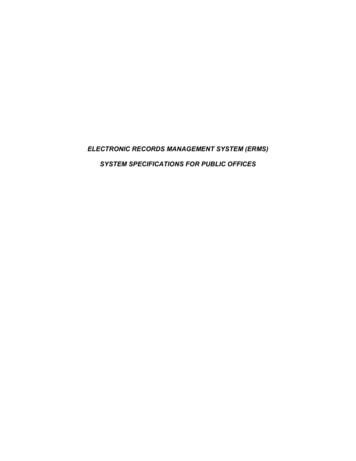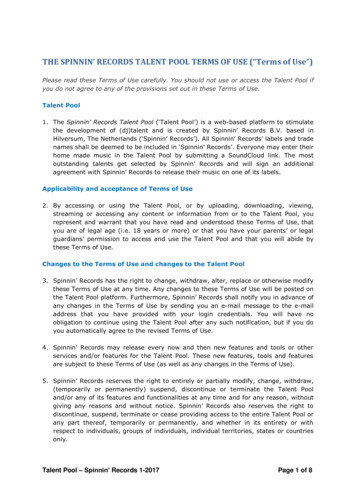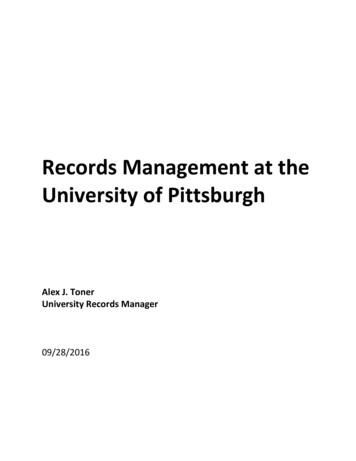
Transcription
Records Management at theUniversity of PittsburghAlex J. TonerUniversity Records Manager09/28/2016
ContentsIntroduction . . 3Defining Records 4Records Management at Pitt 5History of records management at PittDecentralized records authority and managementRetention Schedules and RegulationsUniversity records management and the University ArchivesRecords Management at Other Universities . 8University of VirginiaKansas State UniversityPenn StateTemple UniversityRecordkeeping in the News 10Freeh ReportOregon email and record releaseUniversity of Illinois President email scandalDefensibility at Pitt 14Record types at PittApplication and ManagementRM education across campusResponsibility of RM ProgramStrategic Actions and Recommendations . 18Strategic ActionsAspirational RecommendationsConclusion 22Sources . 23Appendix Attached1) Applicable Records Management Regulations2) University of Pittsburgh Archives, 19772
IntroductionUniversity records management is sometimes an overlooked service in terms of administrativeand operational effectiveness. Often construed in terms of “what can I keep?” or “what can Ithrow away?” the overall benefit to the efficiency and defensibility of the institution isunderestimated. “Benefits of an effective records management program include legalprotection, identification of important evidence, elimination of noncritical information, greateraccess to vital records, more efficient information storage and retrieval, and preservation ofhistorical materials.”1 More than simply knowing what to throw away and what to keep,University records management services are defined by important legal, financial, operational,and historical factors.The University Records Management Program at the University of Pittsburgh should stimulatean environment of openness, accountability, and transparency in order to promote informationmanagement integrity.2 Academic research universities like the Pitt are generating informationat a hereto unforeseen scale. General correspondence, admission and academic records,curriculum, financial records, general administrative records, grant and contract records,human resources, athletic certifications, alumni records, publications, and special programs andevents are all record types the University generates to conduct daily business.Hardcopy records exchanged by mail or delivery have evolved into a complex mix of paper andelectronic records, scanned documents and those “born-digital,” emails and instant messenger,databases and cloud-based storage systems. The result is an ever-growing network ofinformation to navigate and manage requiring financial and staff resources, education andawareness, infrastructure adjustments, and changes in recordkeeping culture.To best meet the needs of modern recordkeeping the University of Pittsburgh shouldreevaluate its records management strategy to be sure a positive, trustworthy, and pro-activeapproach is employed. Records may bring national attention to a University, for better or forworse, in the same way the success or failure of a research initiative or athletic program would.In many cases Universities are forced into a reactive position concerning records, scrambling toaddress policy gaps, structural deficiencies, or ineffective communication. Such positionweakens the University’s records management defensibility. A pro-active approach serves toembolden records facilitators across campus and strengthen the institutional foundation of theUniversity.1Purcell, Aaron D. Academic Archives: Managing the Next Generation of College and University Archives, Records,and Special Collections. Chicago Illinois: Neal-Schuman, 2012. Pg. 121.2“The overall purpose of having a records management program, for both paper and digital records, is to supportand enhance the activities of the organization” Purcell, Pg. 121.3
That foundation should be built on transparency, efficiency, and defensibility. As a state-relatedinstitution the University of Pittsburgh is not subject to the degree of open records requeststhat other large public universities are legally beholden to. However, this does not preclude Pittfrom maintaining a comparable level of policy and diligence concerning its records in order tocomply with best practices and maintain trustworthy and defensible policies.This paper will detail how the University of Pittsburgh will benefit from a reexamination of itsrecords management services and activities by describing the history of records management atthe University of Pittsburgh, surveying selected records management services at comparableuniversities, presenting examples of higher education recordkeeping in the news, addressingthe defensibility of current records management procedures at Pitt, and presenting severalstrategic and aspirational recommendations the University can pursue.Defining RecordsThis section will provide definitions of a “record” as considered for this paper within the contextof higher education and the University of Pittsburgh.ARMA International defines a record as a “fixed piece of information generated in analog orelectronic formats that document an event or transaction”.3 The Society of American Archivistsdefines a record as “a written or printed work of a legal or official nature that may be used asevidence or proof; a document” or “data or information that has been fixed on some medium;that has content, context, and structure; and that is used as an extension of human memory orto demonstrate accountability”.4The Commonwealth of Pennsylvania’s Right to Know Law defines a record as “information,regardless of physical form or characteristics, that documents a transaction or activity of anagency and that is created, received, or retained pursuant to law or in connection with atransaction, business or activity of the agency”.5Records are created, used, managed, and retained throughout the University every day.Whether they are official correspondence, enrollment applications, research data, gradechange requests, contract agreements or purchase orders, University operations run onrecords. Records remain active as long as they are necessary to conduct daily business. Inactiverecords, no longer necessary for normal business transactions, are retained for a prescribedlength of time or destroyed based on applicable regulations.3Association of Records Managers and Administrators, 2016.Pearce-Moses, Richard. A Glossary of Archival and Records Terminology. Chicago Illinois: Society of AmericanArchivists, 2005.5Pennsylvania Freedom of Information Coalition, 2016; e-rightto-know-law/44
Records are “scheduled” for retention and destruction based on governing guidelines for aparticular record type. Legal requirements at the federal and state level stipulate how recordsare created and who can access them, or how long they need to be retained. Legislation likeFERPA, HIPPA6, and the Employee Records Act require secure, responsible, and focused recordsmanagement practices. Open records laws like the Freedom of Information Act andPennsylvania’s Right to Know Law mandate reasonable access to public records. Inconsistentrecordkeeping practices, outdated policies, or direct negligence increases the liability ofinstitutions under the purview of such legislation.Records chronicling the history of the University, tenures of Chancellor administrations, Boardof Trustees minutes, department growth, faculty achievements, and student life are allcomponents of the University Archives used by Pitt researchers, as well as national andinternational researchers, to produce scholarly research. The University Records Managementprogram helps to identify records of historical significance that document the University’shistorical narrative for potential inclusion in the University Archives.Perhaps the greatest challenge in today’s records management environment are electronicrecords. “The greatest challenge for today’s records managers is electronic records, includingthose born digitally and those reformatted into electronic files.”7 The University RecordsManagement Program identifies and schedules not only hardcopy and paper records, but alsorecords that have been digitized as well as those “born-digital,” or created in a digitalenvironment. Electronic records are generated in a variety of formats, retain a variety ofmetadata, and are stored in a variety of ways across campus. Email, database tables, andelectronic research data are also forms of electronic records that proliferate during theUniversity’s normal course of business.When considering the definition of records, how they are used and created, the varied formsthey take, and the factors regulating their use and retention, the need for a pro-active androbust enterprise-wide records management program emerges as vital to the University toreduce legal liabilities, secure sensitive information, encourage operational efficiency, andpreserve the University of Pittsburgh’s historical identity and memory.Records Management at the University of PittsburghHistory of Records Management at PittThe University Records Management Program (URM) originated in the Business Services Officein 1977. In 1999, the University assigned the URM to the Archives Service Center and enteredinto a contract with Business Records Management, Inc. (BRM), a regional records managementcompany, to store inactive records at several remote facilities around the Pittsburghmetropolitan area. Recall Holdings Ltd. acquired Business Records Management, Inc. in67Family Educational Rights and Privacy Act; Health Insurance Portability Protection Act.Purcell, Pg. 119.5
December 2014. At that time, service to University of Pittsburgh accounts was not altered inany significant fashion.Following a year-long international acquisition process which began in the summer of 2015,Recall Ltd. was purchased by Iron Mountain, Inc. However, a ruling by the U.S. Department ofJustice restricted Iron Mountain’s acquisition of Recall operations in 13 U.S. cities, includingPittsburgh, where such an acquisition would create a monopoly over records storage service. Asa result, a privately-held third-party records and information management service companynamed Access acquired Recall’s Pittsburgh-based storage operation.While Iron Mountain’s acquisition of Recall legally could not include Pittsburgh storageoperations, it was not prohibited from including Recall’s Pittsburgh-based destruction servicesin the purchase. Between May and July 2016, University of Pittsburgh contracted destructionservices were owned by Iron Mountain. The University records manager, together with ULSadministration and University Purchasing, succeeded in July 2016 in terminating IronMountain’s control of the University’s destruction services and consolidating all recordsmanagement services with Access.Access assumed control of all BRM facilities, services, and offices in Pittsburgh, thus thetransition to Access did not affect University records in so much that certified storage security,physical and inventory control, and NAID-certified destruction commitments are concerned.The University of Pittsburgh employs a distributed model of records management that iscentrally lead through the URM program, directed by the University Records Manager. Underthe University’s contract with Access, records management services (excluding supplypurchases) are provided at no cost to the department. Such favorable terms have led to theestablishment of over 400 departmental Access accounts. The University’s agreement withAccess does not include University of Pittsburgh regional campuses, University of PittsburghMedical Center or University of Pittsburgh Physicians’ offices.The mission of the program is “to provide for the efficient and systematic control of thecreation, receipt, maintenance, use and disposition of records. Records administration coversthe management of records, regardless of age, to meet the administrative, financial, legal andhistorical needs within the University of Pittsburgh’s offices and departments.”In partnership with Access, the URM facilitates inactive records storage and secure recordsdestruction. The URM provides guidance on development of retention schedules, consultationon vital records identification and protection, guidelines on procedures to comply with internaland external policies and regulations, training on the classification and inventorying of records,and facilitates the transfer of inactive records to Access and historical records to the UniversityArchives.6
Decentralized AuthorityThe University records manager serves as the authorized liaison between Universitydepartments and Access. The records manager’s job description states that the “recordsmanager will serve as Archives liaison with our campus departments.” This enables adistributed approach in which departments and units are responsible for daily management oftheir records, adherence to retention schedules, and proper identification of records that canbe destroyed. Department’s provide authorization for records destruction, extensions ofdestruction dates, or request records transfers to the University archives. Due to the nature ofa large institution like Pitt, a single records manager cannot maintain central authority overevery business unit within the University. However, policies and mandates are in place to guideand direct University units as necessary.Retention SchedulesA records retention schedule provides specific guidance for the management of records typesand record groups, in consideration of record function and specific office based on legal,financial, and historical precedent.The University of Pittsburgh maintains two primary record retention schedules: the GeneralRetention Schedule and the Financial Records Retention Schedule.8 During the summer of 2000,staff completed record retention and disposal schedules for the Office of the Provost and aGeneral Schedule for the offices, departments, and units reporting to the Provost. The generalschedule provides guidance for the management of certain groups and types of records that arecommon to most offices at the University of Pittsburgh and conforms to established legalrequirements.The Financial Record Retention Schedule, managed by the Office of the Chief Financial Officer,provides specific retention requirements for the central retention of financial records and thedepartmental retention of “convenience copies.” The CFO’s office revised this schedule in May2015.Departments and business units across campus may maintain and adhere to their own specificretention schedules. For example, the Office of the University Registrar’s retention schedule isbased on accredited industry guidance and pertains to student academic records.In addition to internal policies, University records management is largely guided by legalregulations at the local, state, federal, or international level. Appendix one of this documentlists a number of regulations that shape University of Pittsburgh records management policyincluding the aforementioned FERPA, HIPPA, FOIA, and Pennsylvania’s Right to Know Law.98Both General Retention Schedule and the Financial Records Retention Schedule can be found on the University’srecords management website; agement.9See Appendix 1, Applicable Records Management Regulations.7
University Records Management and the University ArchivesA university will benefit from a robust records management program in that it aids in the workof the University Archives. “A solid campus records management program is one indication of asuccessful academic archives program”.10The Archives Service Center blends two of its mission objectives together in utilizing recordsmanagement to proactively advise departments and administrators on record keeping bestpractices during their records’ active management and use. When the time comes for archivalaccession, the records are intellectually arranged in a manner that enhances the archives abilityto process the collection and make it available for public research when applicable.For instance, Archives Service Center staff has begun a dialogue with the Office of ChancellorPatrick Gallagher to advise his office on records keeping practices that will facilitate appropriatetransition of hardcopy and electronic records following his tenure as Chancellor. Collaborationand consultation also positions the University Library System and Archives Service Center ascampus leaders of records and information management.Records Management at other UniversitiesThe University of Pittsburgh’s University Records Management Program (URM) can beconsidered an established program, having been created in 1977. This section is intended toprovide a surface-level look of records management programs at four selected universities thatfall into the following categories: large public university with an established RM program; largepublic university currently establishing a RM program; large state-related PA University withestablished RM program; and a medium state-related university with no centralized recordsmanagement program. This section will provide a scope through which to view Pitt’s currentURM resources and initiatives, as well as a survey of common RM objectives that Pitt canpotentially employ.University of VirginiaThe University of Virginia (UVA) is a public university and considered a state agency with anestablished records management program (est. 1996) that adheres directly to the VirginiaPublics Records Act for retention directions. Currently, the University employs three devotedrecords management staff: the University records officer and two records managementanalysts.In 2008, a records management team comprised of 12 stakeholders from around the Universitysubmitted a report11 containing an in-depth analysis of records management practices at UVA,10Purcell, Pg. 113Executive Summary for Process Simplification Steering Committee Records Management Project. University ofVirginia, 2008.118
which led to an overhaul of the program and adoption of policies steering the institution to theits current position in 2016.A full-time records officer was hired in 2008 who reports to the chief information officer withinthe Information, Security, Policy and Records Office (ISPRO). The UVA records program requiresfaculty and staff to comply with University Policy and state law and “cooperate with theUniversity Records Officer.”The UVA university records management office (URMO) provides consultations, developmentof policies, and training sessions. Records management at the UVA provides guidance on emailmanagement, electronic records management, scanning and reformatting, transferring recordsto special collections, and records storage.The URMO offers 12 in-depth training classes for a variety of stakeholders across campus. Italso offers seven task-specific classes on topics such as “email management, electronic recordsmanagement, going paperless, and organizing your records.” The program encouragesdepartments to establish clear designation of records administrators and records coordinators,with details on responsibilities and competencies.12Because the URMO manages all University records storage, the office maintains a web-basedapplication that assists units in managing their physical records. The tool also allows UVA unitsto manage inventories of electronic records that have been submitted for digital storage.Kansas State UniversitySimilar to the University of Virginia, Kansas State University (KSU) is a large, public University.Prior to 2015, KSU had limited records and information management infrastructure across itcampuses primarily managed through the University Library and Archives Program. In 2014, theUniversity convened a university records task force to study and guide the creation of a recordsmanagement program.In May 2015 the task force delivered their final recommendations, which included establishinga standing university records committee, hiring a records manager, assigning an office ofrecords, improving electronic recordkeeping systems, updating KSU policies and proceduresmanual, creating records and information management training, and evaluating mission criticalrecords.13Penn State UniversityPenn State University is one of four state-related universities, including the University ofPittsburgh, within the state of Pennsylvania. Records management is located under theUniversity Library within the Eberly Family Special Collections Library. The department1213UVA Records Management Website, 2016; http://www.virginia.edu/recordsmanagement/.Final Report of University Records Task Force. Kansas State University, 05/18/2015.9
maintains two staff members – a records manager for archival and permanent records and arecords management officer.Penn State record management services is a codified service by University Policy.14 Serviceobjectives include records management training and information dissemination, recordssurveys and consultation, managing the University-controlled inactive records center,overseeing records management liaisons, and hosting an annual on-campus recordsmanagement summit.15Additionally, records management services are guided by the input and recommendations ofthe records management advisory committee (RMAC), consisting of nearly 30 Penn StateUniversity stakeholders convening since the 1980s.In July of 2015, Penn State University began requiring “proof of records retentioncompliance,”16 requiring all University business units to annually review their records anddocument their retention, disposition, and/or destruction. The review is submitted to therecords management program via the unit’s records liaison as mandated under the codifiedrecords management policy.Temple UniversitySimilar to Penn State and Pitt, Temple University is state-related university. The UniversityArchives falls under the Special Collections Research Center and Conwellana-TemplanaCollection. According to the Director of the Special Collections Research Center, requests fromthe Libraries to establish a records management program have not been approved. Oversight isdecentralized, with departments wholly responsible for records management compliance.Temple University Libraries work informally with offices to move records with long-term valueto the archives to the best of their ability, and retain no control or authority over managementof active University records.ConclusionMost Universities are recognizing the need to establish records management programs orupdate existing programs to meet the challenges of 21st century recordkeeping. Commonthemes from each of the four examples include training initiatives, record advisory committees,and documenting destruction of records to management liability.Recordkeeping in the NewsRecords and information are often at the center of events, whether positively or negatively.Negative attention usually results from litigation or scandal, bringing to light inadequate14Penn State Policy AD35 University Archives and Records Management; http://guru.psu.edu/policies/AD35.html.Eberly Special Collection Website, 2016; records.html16“New rules govern retention of records,” 07/6/2015; lesgovern-retention-records.1510
policies or procedures, or in extreme cases, willful negligence. Examining several recent caseswill provide perspective on the importance of enterprise-wide records management endeavorswhich illustrate the manner in which records, and their management and dissemination, canimpact a University. The need to maintain a pro-active approach involving preparedness,visibility, and trustworthiness which strengthens the institutional foundation of the Universityto weather such storms becomes apparent.Freeh ReportIn the wake of the child abuse scandal (2011) at Penn State University, a Special InvestigativeCounsel was convened to dissect the voluminous amount of records and data associated withthe scandal in order that a true and accurate timeline and account of events be determined.The Report of the Special Investigative Counsel Regarding the Actions of the Pennsylvania StateUniversity Related to the Child Sexual Abuse Committed by Gerald A. Sandusky (Freeh Sporkin &Sullivan, LLP)17 was made public in July 2012 following the criminal trial of Jerry Sandusky. Thereport’s scope note indicates the “ Special Investigative Counsel implemented the investigativeplan by: Analyzing over 3.5 million pieces of pertinent electronic data and documents.”18During the course of its investigation the Special Investigative Counsel highlighted documents,notably emails between senior administrators, as being important to the investigation. “TheSpecial Investigative Counsel had unfettered access to University staff, as well as to data anddocuments maintained throughout the University. The University staff provided a large volumeof raw data from computer systems, individual computers, and communication devices.”19Building on the detailed accounts of methodology, procedures, and findings, the Freeh Reportoffers several recommendations concerning records management, information management,and electronic records from Chapter 10, Section 2.0 of the report:2.2.14 Update computer use policies and regularly inform employees of the University’sexpectations and employee responsibilities with regard to electronic data and materials.2.5 Integrate faculty and staff from different disciplines and areas in University-wideprofessional development/leadership training to increase their exposure to otherUniversity personnel, programs, challenges, and solutions.2.6 Implement consistent, state-of-the art records management and retentionprocedures17“Report of the Special Investigative Counsel Regarding the Actions of the Pennsylvania State University Relatedto the Child Sexual Abuse Committed by Gerald A. Sandusky.” Freeh Sporkin & Sullivan, LLP, July 12, 2012.Contributed to DocumentCloud by Xarissa Holdaway, Chronicle of Higher 396512-report-final-071212.html18Freeh Report, Pg. 10.19Freeh Report, Pg. 11.11
In Section 3.0 the report recommends that a committee on risk, compliance, legal and auditregularly makes reports to the Board of Trustees on “significant issues facing the University” to“mitigate those risks.” The Counsel recommends the University “coordinate a compliancecouncil” of necessary stakeholders (Sec 4.0) and calls for “increased” and “improved” channelsof communication (Sec. 3.5).Due to the importance of police reporting to the investigation, the Counsel outlines clearrecommendations concerning police records in Section 6.4, recommending that Penn State“review records management procedures and controls and revise where needed.”The importance of an updated, transparent, and inclusive records management program isclear when evaluating the Freeh Report. Records, specifically emails, continue to play a majorrole in the public understanding of the scandal and how the Board of Trustees handled certaindecisions following the incident, as the Pittsburgh Post-Gazette reported as recently as March9, 2016.20Oregon Email and Record ReleaseIn December 2014, the University archives at the University of Oregon released a zip drivecontaining nearly 30,000 documents from four presidential administrations to a University ofOregon professor in response to an open records request.21 While the release was madeaccording to the established archival protocols, some records, including presidentialcorrespondence, pertained to exchanges with University faculty, students, and staff.Believed to contain sensitive information, particularly concerning students, the records werereturned after a contentious three-week period. The president’s office raised concerns overpotential FERPA violations resulting from the disclosure of presidential correspondence withparents. Two archivists were placed on paid leave, eventually leading to one employee’stermination and the resignation of the second.22Former University Archivist James Fox spoke to the need of communication and proper staffingbetween campus records management, archives, and data management and curation in anOregonian article in April 2015 to better preempt such situations.Issues of accessibility, restrictions, and embargo notwithstanding, the records managementcomponent of the event displays how transparency and integrity are an importantcharacteristic of a records management program. This is especially true at Pitt, which unlike theUniversity of Oregon, is not subject to the full breadth of public records laws. Consistent20“Penn State emails give insight on key Sandusky decisions.” Pittsburgh Post-Gazette, March 9th ydecisions/stories/201603090081.21“U. of Oregon Scrambles to Retrieve 22,000 Records Released to Professor.” Chronicle of Higher Education,January 21, 2015.22“Cache of Records Released by U. of Oregon Is Returned.” Chronicle of Higher Education. January 28, 2015.12
dialogue, codified policies, and visibility of best practices and resources will stimulate anenvironment of openness, accountability, and transparency.University of Illinois President email scandalIn 2014, the University of Illinois Urbana Champaign rescinded its hiring of professor Steven G.Salaita following the public disclosure of anti-Israel tweets authored by
Access does not include University of Pittsburgh regional campuses, University of Pittsburgh Medical enter or University of Pittsburgh Physicians' offices. The mission of the program is "to provide for the efficient and systematic control of the creation, receipt, maintenance, use and disposition of records. Records administration covers



